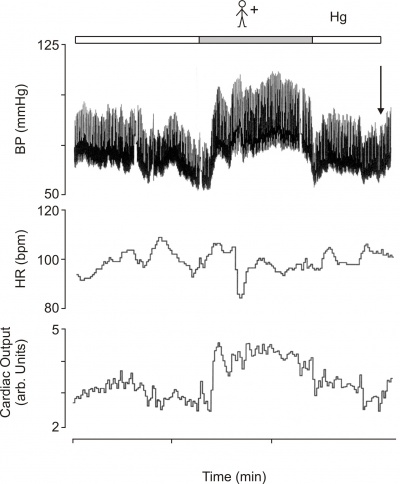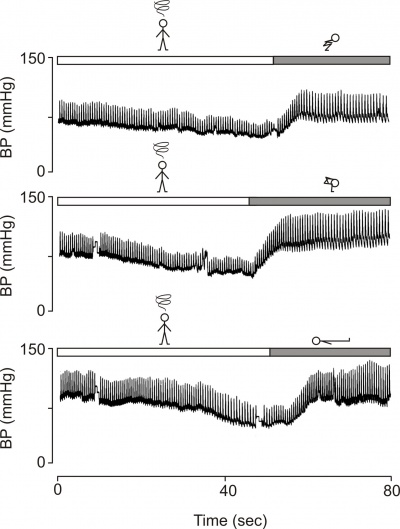Aborting a vasovagal faint by the combination of leg crossing and muscle tensing.
C.T. P. Krediet, N. van Dijk and W. Wieling
Department of Internal Medicine, Academic Medical Center, University of Amsterdam, Amsterdam (The Netherlands)
A 28 years old male patient was evaluated for recurrent episodes of transient loss of consciousness, presumably of vasovagal origin. The episodes typical took place during prolonged standing in a hot environment. Prior to the loss of consciousness he felt light-headed and perspirated heavily.Tilt table testing reproduced these symptoms. Figure 1 shows blood pressure, heart rate and cardiac output during this vasovagal response, measured using Finometer/ Modelflow (FMS, The Netherlands). Note the progressive fall in finger arterial pressure. At the black bar the patient crossed his legs and tensed leg and abdominal muscles as physical counter manoeuvre to combat the vasovagal reaction (Fig. 1). After crossing the legs and tensing of leg and abdominal muscles blood pressure recovered quickly. This rise in blood pressure was associated with a steep increase in cardiac output. Intact baroreflex function causes a short decrease in heart rate when blood pressure overshoots the physiological set point at the start of the manoeuvre.
At the striped bar leg crossing is replaced by single hand gripping as a physical counter manoeuvre. Although there is an effect, it is far less pronounced than during leg crossing and the patient has to be tilted back because of ongoing complaints at a systolic blood pressure of about 75 mm Hg (arrow).
Editor's comments
Inspired by observations that leg crossing and leg muscle tensing increase orthostatic tolerance in patients with autonomic failure (see casus ?? in section orthostatic hypotension) [1], we documented the effectiveness of leg crossing and muscle tensing to postpone or abort vasovagal syncope [2]. Brignole reported a similar effect of arm counterpressure manoeuvres [3]. He based his intervention on the anecdotal advise from some general practitioners in Italy, to apply muscle tensing by gripping a wooden egg (used for darning socks) at the start of an impending faint (REF).
The magnitude of the combination of leg muscle crossing and tensing on blood pressure during a vasovagal reaction is large (Figure 1). The manoeuvre can induce a rise in systolic blood pressure during vasovagal syncope from an average pressure of 65 mmHg at the lowest point to 106 mmHg during the manoeuvre [2]. This rise is caused by mechanical and reflex effects. The acute mechanical effect of reinfusion of pooled blood due to squeezing of venous vessels by skeletal muscle causes a rapid increase in central venous pressure and cardiac output and consequently a rise in blood pressure and cerebral perfusion [4][5]. Reflex effects of muscle tensing are likely to be involved as well in the rise of systemic blood pressure. Tensing of skeletal muscles is associated with activation of a central nervous drive (“central command”) resulting in withdrawal of vagal outflow to the heart and an instantaneous increase in heart rate [6][7]. During maximal isometric muscle contractions central command also induces a rise in sympathetic outflow to blood vessels and thereby in peripheral resistance with stabilization of blood pressure [7].
Tensing of skeletal muscle and the consequent stimulation of mechanical receptors in these muscles elicits a reflex increase in muscle sympathetic nerve activity Muscle chemo-afferents are activated only after ~1 minute of sustained muscle contractions. Activation of the muscle chemoreflex is therefore not likely to play an important role in the instantaneous blood pressure rising effect of physical counterpressure manoeueuvres[7]. Skeletal muscle contractions can also induce an instantaneous increase in heart rate by reducing vagal outflow to the heart (muscle-heart reflex)[7][8]. The specific physiological effects underlying the ability to abort vasovagal syncope completely are currently under investigation.
Alternative physical counterpressure manoeuvres applied to abort an impending faint are arm-tensing and lower body tensing [3][9]. Arm-tensing consists of strong isometric contraction of the two arms, achieved by gripping one hand with the other and contemporarily abducting the arms[3]. The effects of arm-tensing differ in our experience from simple hand gripping, which is ineffective in postponing vasovagal syncope (Figure 1). We suggest that the effectiveness of arm-tensing is based on whole body tensing which is performed during these manoeuvres.
When serious symptoms of an impending faint occur, squatting or sitting down with the head bend between the knees can be applied (Fig. 2)[10].
References
<biblio>
- Wieling pmid=8477182
- Krediet pmid=12270863
- Brignole pmid=12475469
- VanLieshout pmid=11441199
- VanDijk pmid=15475601
- Thornton pmid=11410638
- VanDijk2 van Dijk, N., Krediet, C. T., de Bruin, I. G. J. M., van Lieshout, J. J., and Wieling, W. Physical counterpressure maneuvers to prevent and abort vasovagal syncope: a novel effective treatment? In: Raviele, A. Cardiac arrhythmias 2003. Proceedings of the 8th international workshop on cardiac arrhythmias. Springer Milan 2003: pp 633-639.
- Gladwell pmid=11986394
- Sabin pmid=11513019
- Krediet2 pmid=12842648
<biblio>

